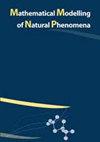肿瘤免疫反应的表型结构模型
IF 2.1
4区 数学
Q2 MATHEMATICAL & COMPUTATIONAL BIOLOGY
引用次数: 1
摘要
本文从免疫检查点抑制剂免疫治疗的角度提出了肿瘤-免疫反应相互作用的数学模型。该模型是非局部积分-微分Lotka-Volterra型,其中细胞群体的异质性通过结构变量来考虑,这些变量是每个细胞中存在的连续内部特征(又名表型)。这些代表了一种集中的“侵略性”,即,对于肿瘤细胞来说,恶性被理解为在免疫细胞或药物攻击下以存活状态茁壮成长的能力——我们建议将其确定为去分化的潜力——对于免疫细胞来说,杀死肿瘤细胞的能力,换句话说,抗肿瘤功效。我们分析了在没有处理的情况下模型的渐近行为。在先验收敛假设下,利用两个定理刻画了积分-微分系统的极限。我们用一些数值模拟来说明我们的结果,这表明我们的模型再现了免疫编辑的三个e:消除、平衡和逃逸。最后,我们举例说明了ici对这三个e可能产生的影响。本文章由计算机程序翻译,如有差异,请以英文原文为准。
A phenotype-structured model for the tumour-immune response
This paper presents a mathematical model for tumour-immune response interactions in the perspective of immunotherapy by immune checkpoint inhibitors ICIs). The model is of the nonlocal integro-differential Lotka-Volterra type, in which heterogeneity of the cell populations is taken into account by structuring variables that are continuous internal traits (aka phenotypes) present in each individual cell. These represent a lumped ``aggressiveness'', i.e., for tumour cells, malignancy understood as the ability to thrive in a viable state under attack by immune cells or drugs - which we propose to identify as a potential of de-differentiation -, and for immune cells, ability to kill tumour cells, in other words anti-tumour efficacy. We analyse the asymptotic behaviour of the model in the absence of treatment. By means of two theorems, we characterise the limits of the integro-differential system under an a priori convergence hypothesis. We illustrate our results with a few numerical simulations, which show that our model reproduces the three Es of immunoediting: elimination, equilibrium, and escape. Finally, we exemplify the possible impact of ICIs on these three Es.
求助全文
通过发布文献求助,成功后即可免费获取论文全文。
去求助
来源期刊

Mathematical Modelling of Natural Phenomena
MATHEMATICAL & COMPUTATIONAL BIOLOGY-MATHEMATICS, INTERDISCIPLINARY APPLICATIONS
CiteScore
5.20
自引率
0.00%
发文量
46
审稿时长
6-12 weeks
期刊介绍:
The Mathematical Modelling of Natural Phenomena (MMNP) is an international research journal, which publishes top-level original and review papers, short communications and proceedings on mathematical modelling in biology, medicine, chemistry, physics, and other areas. The scope of the journal is devoted to mathematical modelling with sufficiently advanced model, and the works studying mainly the existence and stability of stationary points of ODE systems are not considered. The scope of the journal also includes applied mathematics and mathematical analysis in the context of its applications to the real world problems. The journal is essentially functioning on the basis of topical issues representing active areas of research. Each topical issue has its own editorial board. The authors are invited to submit papers to the announced issues or to suggest new issues.
Journal publishes research articles and reviews within the whole field of mathematical modelling, and it will continue to provide information on the latest trends and developments in this ever-expanding subject.
 求助内容:
求助内容: 应助结果提醒方式:
应助结果提醒方式:


